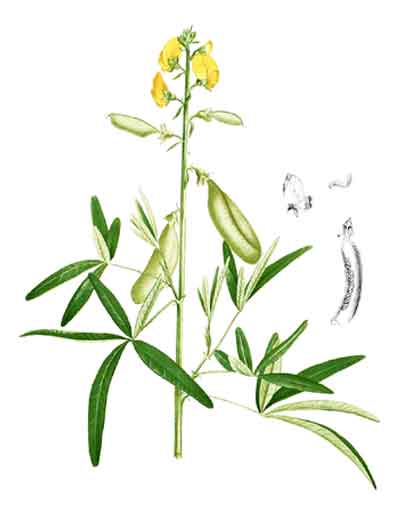
Family • Leguminosae / Fabaceae
Suso-susoyan
Crotalaria quinquefolia Linn.
RATTLEBOX
| Scientific names | Common names |
| Crotalaria quinquefolia Linn. | Buli-lawa (Tag.) |
| Crotalaria heterophylla L.f. | Katanda (Tag.) |
| Palpaltog (Tag.) | |
| Putokan (Tag.) | |
| Suso-susoyan (Tag.) | |
| Susoi (Tag.) | |
| Fiveleaf crotalaria (Engl.) | |
| Rattlebox (Engl.) | |
| Wild wetland sannhemp (Engl.) | |
| Putokan is a local name shared by (1) Crotalaria retusa, kalog-kalog (2) Crotalaria quinquefolia, suso-susoyan,and (3) Physalis angulata, putokan. | |
| Crotalaria quinquefolia L. is an accepted name. The Plant List | |
| Other vernacular names |
| FRENCH: Crotalaire á cinq feuilles. |
| INDIA: Kambe, Kambi, Neerugili gichha, wellia-tandale-cotti. |
| OTHERS: Sen, Sonnette, Tcha-tach. |
Botany
Constituents Properties Caution Availability |
Updated October 2018 / February 2017
December 2011
![]()
 |
| IMAGE SOURCE: Photograph / Flowers and Seeds / Crotalaria quinquefolia / Flowers and Leaves / by J.M.Garg / Click on image to go to source page / Creative Commons Attribution-NonCommercial-ShareAlike 3.0 Unported License / Useful Tropical Plants |
| IMAGE SOURCE: Illustration: File:Crotalaria quinquefolia Blanco1.159.png / Flora de Filipinas / 1880 - 1883 / Francisco Manuel Blanco (O.S.A) / Wikimedia Commons |
Additional
Sources and Suggested Readings |
| It is not uncommon for links on studies/sources to change. Copying and pasting the information on the search window or using the DOI (if available) will often redirect to the new link page. |
• |
 |

 Gen info
Gen info Distribution
Distribution